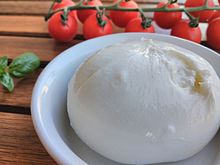Burrata

Burrata is an Italian filata type cream cheese .
Burrata is a special form of mozzarella , but is mainly made from cow's milk (more rarely from buffalo milk) and has around 44% or 60% fat in the Tr. It has the shape of a small bag, which is similar to a mozzarella, and inside of which there is a mass of cream and mozzarella strands (mozzarella mass that is practically not shaped into balls); the filling is similar to stracciatella . The diameter is usually 10 to 12 cm, the weight about a third to half a kilogram. The burrata is on site i. d. Usually delivered in Italy and over short distances usually without packaging, ie in vats in brine, and also packed like mozzarella in plastic bags with brine. In the past, the burrata was often wrapped in the green leaves of the affodill , which gave it a special taste. From the green leaves you could tell whether the burrata was still fresh. Due to hygiene regulations, the leaves have been replaced with green plastic, but these days this is disappearing more and more. Burrata means “buttered” in Italian, which indicates the creamy consistency.
Taste: fresh in Italy you can taste the fresh cream and a sweet note. Export goods for foreign countries can be preserved for up to 20 days by light preservation. Therefore there are slight differences in taste. However, the delicate core of cream and stracciatella should not taste sour, otherwise the burrata is already spoiled.
The burrata was invented near Andria in 1956 when heavy snowfall prevented the milk from being transported to the village from farms outside the town. To preserve the cream, it was packed in mozzarella bags.
Since 2016 the cheese has been recognized as a Burrata di Andria PGI in the European Union.
consumption
The burrata can be eaten directly with a little skill and sucking bites (like an apple). The filling runs out on the plate with knife and fork, but can be dunked with bread. It is also eaten prepared with tomatoes (as is common for mozzarella in the Insalata Caprese ). You can also enjoy the burrata with pasta or as a topping on the pizza .
Web links
Individual evidence
- ^ Anna Burghardt: Burrata: Stracciatella in a Sackerl. In: diepresse.com . March 16, 2015, accessed April 4, 2019 .
- ↑ a b c David Gibbons: burrata . In: Catherine Donnelly (Ed.): The Oxford companion to cheese . Oxford University Press , New York 2016, ISBN 978-0-19-933088-1 , pp. 95 .
- ↑ a b Burrata di Andria. Brochure. (No longer available online.) Associazione Produttori Burrata di Andria, archived from the original on September 12, 2017 ; accessed on February 14, 2015 .
- ↑ Implementing Regulation (EU) 2016/2103 of the Commission of November 21, 2016 for the entry of a name in the register of protected designations of origin and protected geographical indications [Burrata di Andria (PGI)] . In: Official Journal of the European Union . L327, 32016R2103, December 2, 2016 ( europa.eu ).

